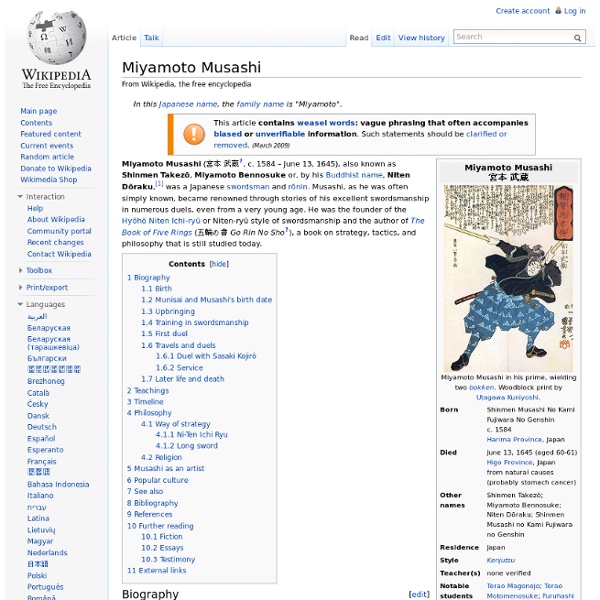Miyamoto Musashi

The Book of Five Rings
The Book of Five Rings (五輪書, Go Rin No Sho?) is a text on kenjutsu and the martial arts in general, written by the swordsman Miyamoto Musashi circa 1645. There have been various translations made over the years, and it enjoys an audience considerably broader than only that of martial artists: for instance, some business leaders find its discussion of conflict and taking the advantage to be relevant to their work. Musashi establishes a "no-nonsense" theme throughout the text. Musashi describes and advocates a two-sword style (nitōjutsu): that is, wielding both katana and wakizashi, contrary to the more traditional method of wielding the katana two-handed. The five books[edit] Although it is difficult to grasp it from the book, Go Rin No Sho, these books are actually the teachings which Musashi preached to his students in his own dōjō. The term "Ichi School" is referred to in the book, Go Rin No Sho. The Book of Earth[1][edit] In The Book of Five Rings he writes on timing: See also[edit]
Samurai
Samurai around the 1860s Samurai (侍?), usually referred to in Japanese as bushi (武士? By the end of the 12th century, samurai became almost entirely synonymous with bushi, and the word was closely associated with the middle and upper echelons of the warrior class. History Asuka and Nara periods Following the Battle of Hakusukinoe against Tang China and Silla in 663 AD that led to a Japanese retreat from Korean affairs, Japan underwent widespread reform. The Taihō Code classified most of the Imperial bureaucrats into 12 ranks, each divided into two sub-ranks, 1st rank being the highest adviser to the Emperor. Heian period In the early Heian period, the late 8th and early 9th centuries, Emperor Kammu sought to consolidate and expand his rule in northern Honshū, but the armies he sent to conquer the rebellious Emishi people lacked motivation and discipline, and failed in their task. Ultimately, Emperor Kammu disbanded his army. Kamakura Bakufu and the rise of samurai Ashikaga Shogunate
Bushido
Japanese samurai in armour, 1860s. Photograph by Felice Beato Bushidō (武士道?), literally "samurai's way", is a Japanese word for the way of the samurai life, loosely analogous to the concept of chivalry. Bushido, a modern term rather than a historical one, originates from the samurai moral values, most commonly stressing some combination of frugality, loyalty, martial arts mastery, and honor unto death. Under the Tokugawa Shogunate, some aspects of warrior values became formalized into Japanese feudal law.[2] The word was first used in Japan during the 17th century.[3] It came into common usage in Japan and the West after the 1899 publication of Nitobe Inazō's Bushido: The Soul of Japan.[4] In Bushido (1899), Nitobe wrote: ...Bushidō, then, is the code of moral principles which the samurai were required or instructed to observe.... Nitobe was not the first person to document Japanese chivalry in this way. Historical development[edit] Early history to 11th century[edit] Tenets[edit]
Related:
Related:



